GE JCT 915, JCK 915 User Manual

Built-In Oven
Electric Convection
www.geappliances.ca
Safety Instructions . . . . . . . . .2–4
Operating Instructions
Clock and Timer . . . . . . . . . . . .11
Convection . . . . . . . . . . . . . .14–18
Probe . . . . . . . . . . . . . . . . . .13, 18
Proofing . . . . . . . . . . . . . . . . . . .19
Sabbath Feature . . . . . . . . . . . . .8
Self-Cleaning Oven . . . . . . .21, 22
Thermostat . . . . . . . . . . . . . . . .20
Timed Baking
and Roasting . . . . . . . . .12, 16–17
Using the Oven . . . . . . . . . . .5–22
Warming . . . . . . . . . . . . . . . . . .19
Care and Cleaning
Broiler Pan and Grid . . . . . . . . .25
Cleaning Oven Door . . . . . . . . .24
Control Panel . . . . . . . . . . . . . .26
Lift-Off Oven Door . . . . . . . . . .24
Light Bulb . . . . . . . . . . . . . . . . .23
Oven Floor . . . . . . . . . . . . . . . .24
Probe . . . . . . . . . . . . . . . . . . . . .25
Racks . . . . . . . . . . . . . . . . . . . . .25
Removing Packaging Tape . . . .23
Stainless Steel Surfaces . . . . . . .26
Troubleshooting Tips . . . . .27–29
Consumer Support
Consumer Support . . . . . . . . . .32
Warranty . . . . . . . . . . . . . . . . . .31
Write the model and serial numbers here:
Model # __________________
Serial #____________________
You can find them on a label on the front of the oven behind the oven door.
Owner’s Manual
JCK915–27 ″ Single Wall Oven
JCT915–30 ″ Single Wall Oven
350A4502P236 229C4020P316 29-5031 07-02 JR

Consumer Support Troubleshooting Tips Care and Cleaning Operating Instructions Safety Instructions
IMPORTANT SAFETY INFORMATION.
READ ALL INSTRUCTIONS BEFORE USING.
 WARNING!
WARNING!
For your safety, the information in this manual must be followed to minimize the risk of fire or explosion, electric shock, or to prevent property damage, personal injury, or loss of life.
IMPORTANT SAFETY NOTICE
The California Safe Drinking Water and Toxic Enforcement Act requires the Governor of California
to publish a list of substances known to the state to cause cancer, birth defects or other reproductive harm, and requires businesses to warn customers of potential exposure to such substances.
The fiberglass insulation in self-clean ovens gives off a very small amount of carbon monoxide during the cleaning cycle. Exposure can be minimized by venting with an open window or using a ventilation fan or hood.
SAFETY PRECAUTIONS
When using electrical appliances, basic safety precautions should be followed, including the following:
■Use this appliance only for its intended purpose as described in this Owner’s Manual.
■Be sure your appliance is properly installed and grounded by a qualified technician in accordance with the provided installation instructions.
■Do not attempt to repair or replace any part of your oven unless it is specifically recommended in this manual. All other servicing should be referred to a qualified technician.
■Have the installer show you the location of the circuit breaker or fuse. Mark it for easy reference.
■Before performing any service, disconnect the oven power supply at the household distribution panel by removing the fuse or switching off the circuit breaker.
■Do not leave children alone—children should not be left alone or unattended in an area where an appliance is in use. They should never be allowed to sit or stand on any part of the appliance.
■Do not allow anyone to climb, stand or hang on the door. They could damage the oven, or cause severe personal injury.
■Be sure the oven is securely installed in a cabinet that is firmly attached to the house structure. Never allow anyone to
climb, sit, stand or hang on the oven door.
■Never leave the oven door open when you are not watching the oven.
■Always keep combustible wall covering, curtains or drapes a safe distance from your oven.
■Always keep dish towels, dish cloths, pot holders and other linens a safe distance from your oven.
■Always keep wooden and plastic utensils and canned food a safe distance away from your oven.
■Teach children not to play with the controls or any other part of the oven.
■Large scratches or impacts to glass doors can lead to broken or shattered glass.
2

www.geappliances.ca
 WARNING!
WARNING!
 SAFETY PRECAUTIONS
SAFETY PRECAUTIONS
 ■ Do not store flammable materials in
■ Do not store flammable materials in
an oven.
■ CAUTION: Items of interest to children should not be stored in cabinets above an oven; children climbing on the oven to reach items could be seriously injured.
■Never wear loose-fitting or hanging garments while using the appliance. Be careful when reaching for items stored in cabinets over the oven. Flammable material could be ignited if brought in contact with hot surfaces or heating elements and may cause severe burns.
■Use only dry pot holders—moist or damp pot holders on hot surfaces may result in burns from steam. Do not let pot holders touch hot heating elements. Do not use a towel or other bulky cloth.
■For your safety, never use your appliance for warming or heating the room.
■Do not let cooking grease or other flammable materials accumulate in or near the oven.
■Do not use water on grease fires. Never pick up a flaming pan. Turn the controls off.
■Flame in the oven can be smothered completely by closing the oven door and turning the oven off or by using a multipurpose dry chemical or foam-type fire extinguisher.
■Do not touch the heating elements or the interior surface of the oven. These surfaces may be hot enough to burn even though they are dark in color. During and after use, do not touch, or let clothing or other flammable materials contact any interior area of the oven; allow sufficient time for cooling first.
■Potentially hot surfaces include oven vent openings, surfaces near the openings, crevices around the oven door, the edges of the window and metal trim parts above the door.
■REMEMBER: The inside surface of the oven may be hot when the door is opened.
■Never leave jars or cans of fat drippings in or near your oven.
■Do not store or use combustible materials, gasoline or other flammable vapors and liquids in the vicinity of this or any other appliance.
■Stand away from the oven when opening the oven door. Hot air or steam which escapes can cause burns to hands, face and/or eyes.
■Do not heat unopened food containers. Pressure could build up and the container could burst, causing an injury.
■Keep the oven vent unobstructed.
■Keep the oven free from grease buildup.
■Place the oven shelf in the desired position while the oven is cool. If shelves must be handled when hot, do not let pot holder contact the heating elements.
■When using cooking or roasting bags in the oven, follow the manufacturer’s directions.
■Pulling out the shelf to the stop-lock is a convenience in lifting heavy foods. It is also a precaution against burns from touching hot surfaces of the door or oven walls.
■Do not use the oven to dry newspapers. If overheated, they can catch on fire.
■Do not use the oven for a storage area. Items stored in an oven can ignite.
■Do not leave paper products, cooking utensils or food in the oven when not in use.
■After broiling, always take the broiler pan out of the oven and clean it. Leftover grease in the broiler pan can catch fire next time you use the pan.
■Clean only parts listed in this Owner’s Manual.
■Do not use aluminum foil to line oven bottoms, except as suggested in this manual. Improper installation of aluminum foil may result in a risk of electric shock or fire.
3
Support Consumer Tips Troubleshooting Cleaning and Care Instructions Operating Instructions Safety
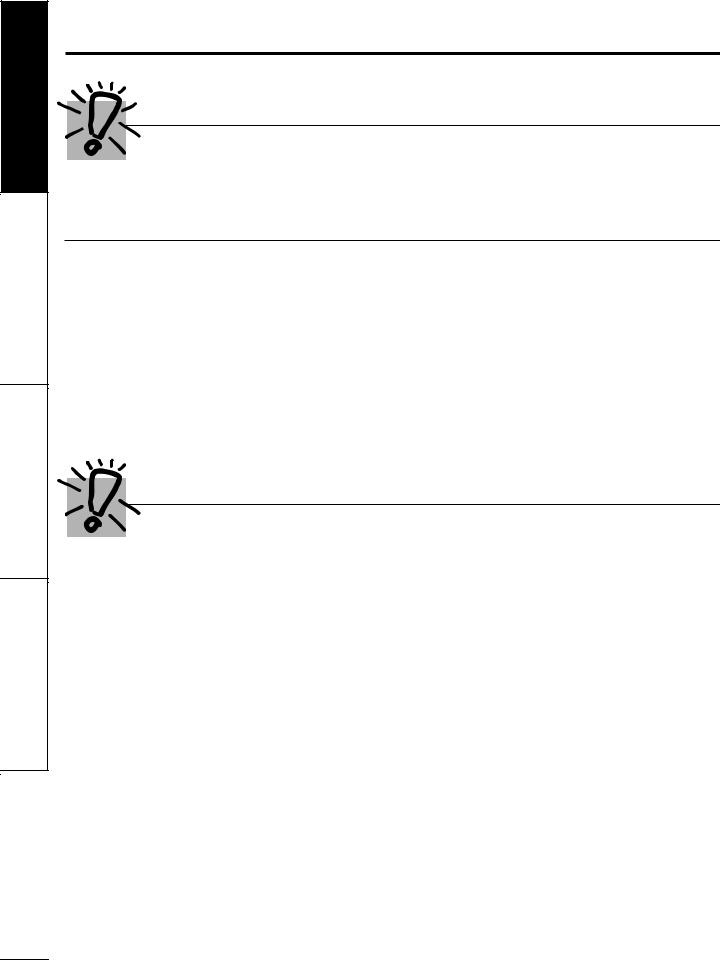
Consumer Support Troubleshooting Tips Care and Cleaning Operating Instructions Safety Instructions
IMPORTANT SAFETY INFORMATION.
READ ALL INSTRUCTIONS BEFORE USING.
COOK MEAT AND POULTRY THOROUGHLY…
Cook meat and poultry thoroughly—meat to at least an INTERNAL temperature of 160°F and poultry to at least an INTERNAL temperature of 180°F. Cooking to these temperatures usually protects against foodborne illness.
SELF-CLEANING OVEN
■Do not clean the door gasket. The door gasket is essential for a good seal. Care should be taken not to rub, damage or move the gasket.
■Do not use oven cleaners. No commercial oven cleaner or oven liner protective coating of any kind should be used in or around any part of the oven. Residue from oven cleaners will damage the inside of the oven when the self-clean cycle is used.
■Before self-cleaning the oven, remove the broiler pan, grid and other cookware.
■Be sure to wipe up excess spillage before starting the self-cleaning operation.
■If the self-cleaning mode malfunctions, turn the oven off and disconnect the power supply. Have it serviced by a qualified technician.
 READ AND FOLLOW THIS SAFETY INFORMATION CAREFULLY.
READ AND FOLLOW THIS SAFETY INFORMATION CAREFULLY.
SAVE THESE INSTRUCTIONS
4
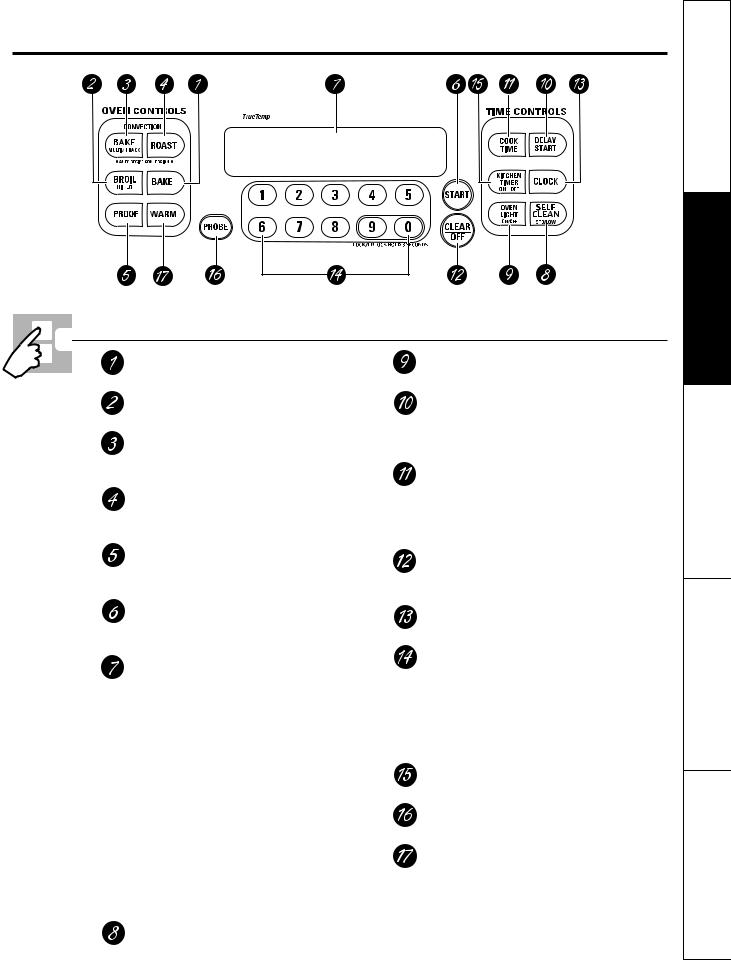
Using the oven controls.
(Throughout this manual, features and appearance may vary from your model.) www.geappliances.ca
Oven Control, Clock and Timer Features and Settings
BAKE Pad
Press to select the bake function.
BROIL HI/LO Pad
Press to select the broil function.
CONVECTION BAKE Pad
Press to select baking with the convection function.
CONVECTION ROAST Pad
Press to select roasting with the convection function.
PROOF Pad
Press to select a warm environment useful for rising yeast-leavened products.
START Pad
Must be pressed to start any cooking or cleaning function.
Display
Shows the time of day, oven temperature, whether the oven is in the bake, broil or self-cleaning mode and the times set for the timer or automatic oven operations.
If “F– and a number or letter” flash in the display and the oven control signals, this indicates a function error code. Press the CLEAR/OFF pad. Allow the oven to cool for one hour. Put the oven back into operation. If the function error code repeats, disconnect the power to the oven and call for service.
If your oven was set for a timed oven operation and a power outage occurred, the clock and all programmed functions must be reset.
The time of day will flash in the display when there has been a power outage.
SELF CLEAN STD/LOW Pad
Press to select self-cleaning function. See the Using the self-cleaning oven section.
OVEN LIGHT ON/OFF Pad
Press to turn the oven light on or off.
DELAY START Pad
Use along with COOK TIME or SELF CLEAN STD/LOW pads to set the oven to start and stop automatically at a time you set.
COOK TIME Pad
Press and then press the number pads to set the amount of time you want your food to cook. The oven will shut off when the cooking time has run out.
CLEAR/OFF Pad
Press to cancel ALL oven operations except the clock and timer.
CLOCK Pad
Press before setting the clock.
Number Pads
Use to set any function requiring numbers such as the time of day on the clock, the timer, the oven temperature, the internal food temperature, the start time and length of operation for timed baking
and self-cleaning.
KITCHEN TIMER ON/OFF Pad
Press to select the timer feature.
PROBE Pad
Press when using the probe to cook food.
WARM Pad
Press to keep cooked foods warm. See the
How to Set the Oven for Warming section.
5
Support Consumer Tips Troubleshooting Cleaning and Care Instructions Operating Instructions Safety

Consumer Support Troubleshooting Tips Care and Cleaning Operating Instructions Safety Instructions
Special features of your oven control.
Your new touch pad control has additional features that you may choose to use. The following are the features and how you may activate them.
The special feature modes can only be activated while the display is showing the time of day. They remain in the control’s memory until the steps are repeated.
When the display shows your choice, press the START pad. The special features will remain in memory after a power failure, except for the Sabbath feature, which will have to be reset.
12-Hour Shut-Off
With this feature, should you forget and leave the oven on, the control will automatically turn off the oven after 12 hours during baking functions or after 3 hours during a broil function.
If you wish to turn OFF this feature, follow the steps below.
Press the BAKE and BROIL HI/LO pads at the same time for 3 seconds, until the display shows SF.
Press the DELAY START pad until no shdn (no shut-off) appears in the display.
Press the START pad to activate the no shut-off and leave the control set in this special features mode.
12-Hour, 24-Hour or Clock Black-Out
Your control is set to use a 12-hour clock.
If you would prefer to have a 24-hour military time clock or black out the clock display, follow the steps below.
Press the BAKE and BROIL HI/LO pads at the same time for 3 seconds, until the display shows SF.
Press the CLOCK pad once. The display will show 12 hr. If this is the choice you want, press the
START pad.
Press the CLOCK pad again to change to the 24-hour military time clock. The display will show 24 hr. If this is the choice you want, press the START pad.
Press the CLOCK pad again to black out the clock display. The display will show OFF. If this is the choice you want, press the START pad.
NOTE: If the clock is in the black-out mode, you will not be able to use the Delay Start function.
Fahrenheit or Celsius Temperature Selection
Your oven control is set to use the Fahrenheit temperature selections, but you may change this to use the Celsius selections.
Press the BAKE and BROIL HI/LO pads at the same time for 3 seconds, until the display shows SF.
Press the COOK TIME and BROIL HI/LO pads at the same time. The display will show F (Fahrenheit).
Press the COOK TIME and BROIL HI/LO pads again at the same time. The display will show C (Celsius).
Press the START pad.
6
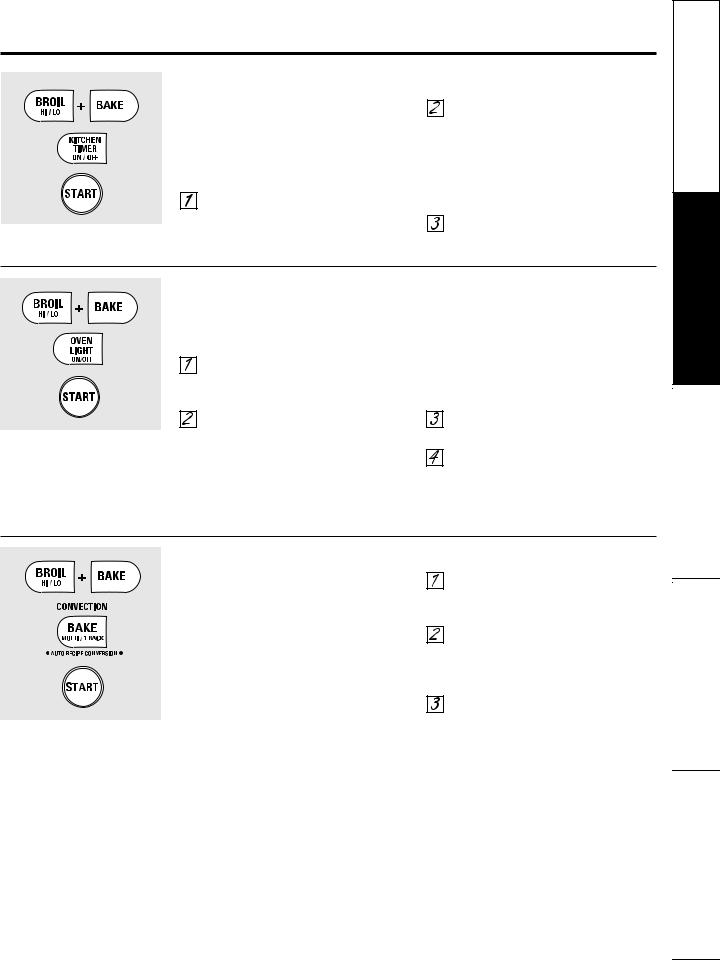
www.geappliances.ca
Tones at the End of a Timed Cycle
At the end of a timed cycle, 3 short beeps will sound followed by one beep every 6 seconds until the CLEAR/OFF pad is pressed. This continuous 6-second beep may be canceled.
To cancel the 6-second beep:
Press the BAKE and BROIL HI/LO pads at the same time for 3 seconds, until the display shows SF.
Press the KITCHEN TIMER ON/OFF pad. The display shows CON BEEP (continuous beep). Press the
KITCHEN TIMER ON/OFF pad again. The display shows BEEP. (This cancels the one beep every 6 seconds.)
Press the START pad.
Tone Volume
This feature allows you to adjust the tone volumes to a more acceptable volume. There are three possible volume levels.
Press the BAKE and BROIL HI/LO pads at the same time for 3 seconds, until the display shows SF.
Press the OVEN LIGHT ON/OFF pad. The display will show 2 BEEP. This is the middle volume level.
Press the OVEN LIGHT ON/OFF pad again. The display will show 3 BEEP. This is the loudest volume level.
Press the OVEN LIGHT ON/OFF pad again. The display will show 1 BEEP. This is the quietest volume level.
For each time the level is changed, a tone will sound to provide an indication of the volume level.
Choose the desired sound level (1 BEEP, 2 BEEP or 3 BEEP).
Press the START pad to activate the level shown.
Using Auto Recipe™ Conversion
When using convection bake, the Auto Recipe™ Conversion feature will automatically convert entered regular baking temperatures to convection baking temperatures.
Once the feature is activated, the display will show the actual converted (reduced)
temperature. For example, if you enter a regular recipe temperature of 350°F and press the START pad, the display will show CON
and the converted temperature of 325°F.
NOTE: This feature does not convert convection bake cooking times, only temperatures.
Press the BAKE and BROIL HI/LO pads at the same time for 3 seconds, until the display shows SF.
Press the CONVECTION BAKE pad. The display will show CON OFF. Press the CONVECTION BAKE pad again. The display will show CON ON.
Press the START pad.
To deactivate the feature, repeat steps 1–3 above but press the START pad when CON OFF is in the display.
7
Support Consumer Tips Troubleshooting Cleaning and Care Instructions Operating Instructions Safety
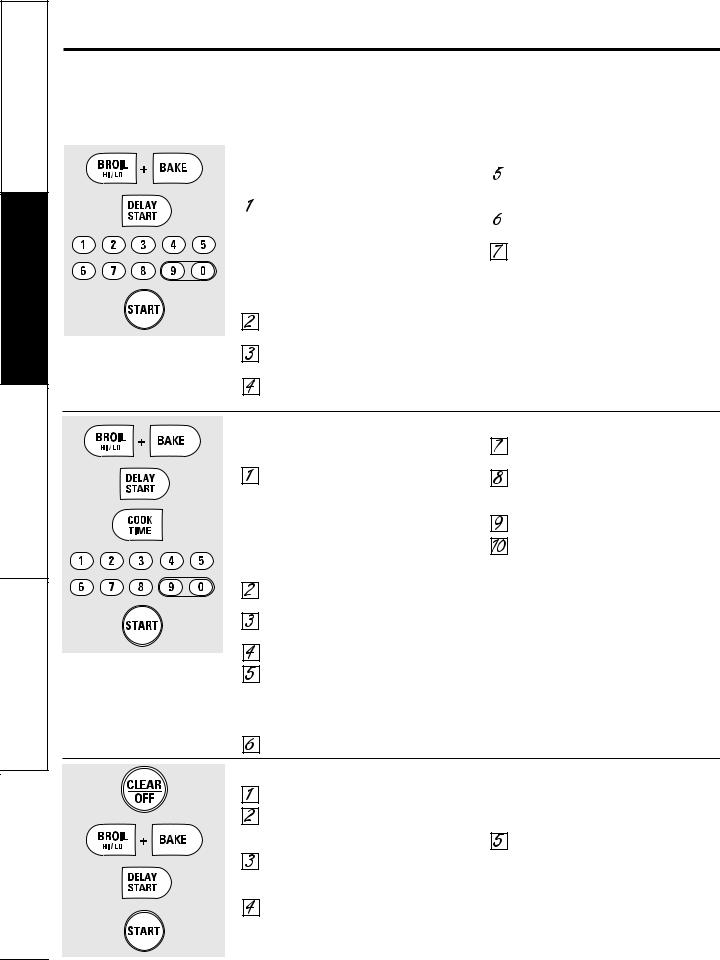
Consumer Support Troubleshooting Tips Care and Cleaning Operating Instructions Safety Instructions
Using the Sabbath Feature.
(Designed for use on the Jewish Sabbath and Holidays.)
The Sabbath feature can be used for baking/roasting only. It cannot be used for convection, broiling, self-cleaning or Delay Start cooking.
NOTE: The oven light comes on automatically (on some models) when the door is opened and goes off when the door is closed. The bulb may be removed. See the Oven Light Replacement section. On models with a light switch on the control panel, the oven light may be turned on and left on.
When the display shows the oven is set in Sabbath. When the display shows the oven is baking/roasting.
How to Set for Regular Baking/Roasting
Make sure the clock shows the correct time of day and |
|
Using the number pads, enter the desired |
|
|
|||
the oven is off. |
|
temperature between 170°F and 550°F. |
|
|
|||
|
Press and hold both the BAKE and BROIL |
|
No signal or temperature will be given. |
|
|
Touch the START pad. |
|
|
HI/LO pads, at the same time, until the |
|
|
|
|
||
|
display shows SF. |
|
|
|
|
||
NOTE: If bake or broil appears in the display, the BAKE and BROIL HI/LO pads were not touched at the same time. Touch the CLEAR/OFF pad and begin again.
Tap the DELAY START pad until SAb bAtH appears in the display.
Touch the START pad and will appear in the display.
Touch the BAKE pad. No signal will be given.
After a random delay period of approximately 30 seconds to 1 minute,will appear in the display indicating that the oven is baking/roasting. If doesn’t appear in the display, start
again at Step 4.
To adjust the oven temperature, touch the BAKE pad, enter the new temperature using the number pads, and touch the START pad.
NOTE: The CLEAR/OFF and COOK TIME pads are active during the Sabbath feature.
When the display shows the oven is set in Sabbath. When the display shows the oven is baking/roasting.
How to Set for Timed Baking/Roasting – Immediate Start and Automatic Stop
Make sure the clock shows the correct time of day and the oven is off.
Press and hold both the BAKE and BROIL HI/LO pads, at the same time, until the display shows SF.
NOTE: If bake or broil appears in the display, the BAKE and BROIL HI/LO pads were not touched at the same time. Touch the CLEAR/OFF pad and begin again.
Tap the DELAY START pad until SAb bAtH appears in the display.
Touch the START pad and will appear in the display.
Touch the COOK TIME pad.
Touch the number pads to set the desired length of cooking time between 1 minute and 9 hours and 99 minutes. The cooking time that you entered will be displayed.
Touch the BAKE pad. No signal will be given.
Using the number pads, enter the desired temperature. No signal or temperature will be given.
Touch the START pad.
After a random delay period of approximately 30 seconds to 1 minute,will appear in the display indicating that the oven is baking/roasting. If doesn’t appear in the display, start
again at Step 7.
To adjust the oven temperature, touch the BAKE pad, enter the new temperature using the number pads, and touch the START pad.
When cooking is finished, the display will change from to and 0:00 will appear, indicating that the oven has turned OFF but is still set in Sabbath. Remove the cooked food.
Touch the START pad.
How to Exit the Sabbath Feature
Touch the CLEAR/OFF pad.
If the oven is cooking, wait for a random delay period of approximately 30 seconds to 1 minute, until only is in the display.
Press and hold both the BAKE and BROIL HI/LO pads, at the same time, until the display shows SF.
Tap the DELAY START pad until 12 shdn or no shdn appears in the display. 12 shdn indicates that the oven will automatically
8
turn off after 12 hours. no shdn indicates that the oven will not automatically turn off.
Touch the START pad.
NOTE: If a power outage occurred while the oven was in Sabbath, the oven will automatically turn off and stay off even when the power returns. The oven control must be reset.
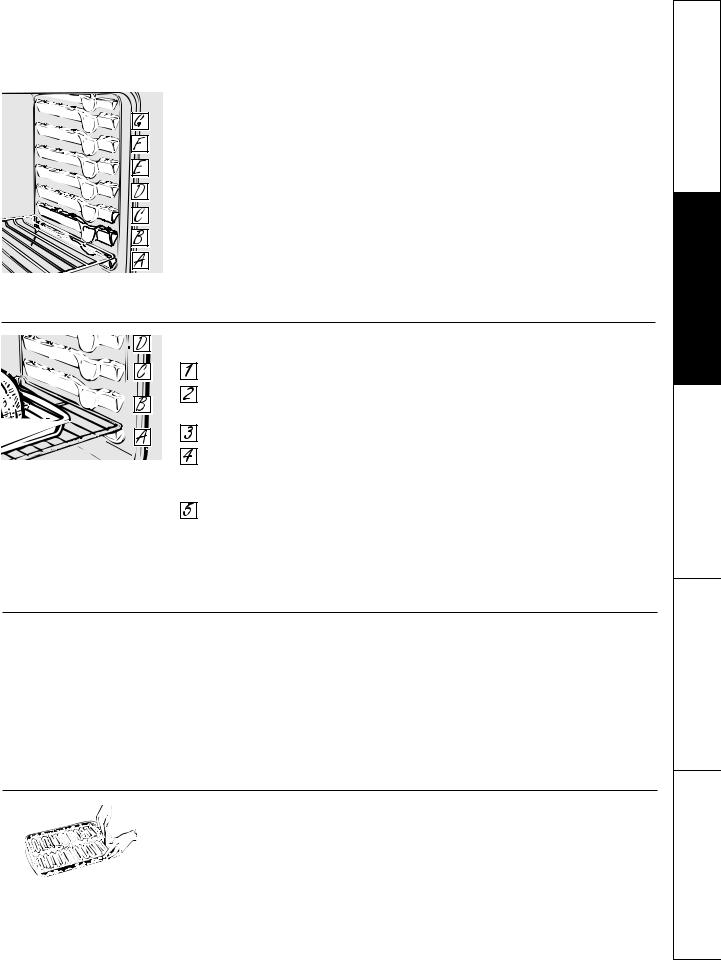
Using the oven. |
www.geappliances.ca |
To avoid possible burns, place the racks in the desired position before you turn the oven on.
Before you begin…
The racks have stop-locks, so that when placed correctly on the supports, they will stop before coming completely out, and will not tilt.
When placing and removing cookware, pull the rack out to the bump on the rack support.
To remove a rack, pull it toward you, tilt the front end up and pull it out.
To replace, place the end of the rack (stop-locks) on the support, tilt up the front and push the rack in.
30″ ovens (shown) have 7 rack positions.
27 ″ovens (shown) have 4 rack positions.
How to Set the Oven for Baking or Roasting
Press the BAKE pad.
Press the number pads to set the desired temperature.
Press the START pad.
Check food for doneness at minimum time on recipe. Cook longer if necessary.
Press the CLEAR/OFF pad when cooking is complete.
NOTE: A cooling fan may automatically turn on and off to cool internal parts. This is normal, and the fan may continue to run even after the oven is turned off.
|
Rack Position |
|
Type of Food 27” Oven |
30” Oven |
|
Frozen pies |
B or C |
C or D |
(on cookie sheet) |
|
|
Angel food cake |
A |
B |
Bundt or pound cakes |
B |
B |
Biscuits, muffins, |
B or C |
C or D |
brownies, cookies, |
|
|
cupcakes, layer |
|
|
cakes, pies |
|
|
Casseroles |
B or C |
C or D |
Preheating and Pan Placement
Preheat the oven if the recipe calls for it. To preheat, set the oven at the correct temperature. Preheating is necessary for good results when baking cakes, cookies, pastry and breads.
For ovens without a preheat indicator light or tone, preheat 10 minutes.
Baking results will be better if baking pans are centered in the oven as much as possible. Pans should not touch each other or the walls of the oven. If you need to use two racks, stagger the pans so one is not directly above the other, and leave approximately 11⁄2″ between pans, from the front, back and sides of the wall.
|
Aluminum Foil |
|
You can use aluminum foil to line the |
|
broiler pan and broiler grid. However, |
|
you must mold the foil tightly to the grid |
|
and cut slits in it just like the grid. |
Cut slits in the foil just like the grid. |
Aluminum foil may also be used to catch a |
|
spillover. |
Never entirely cover a rack with aluminum foil. This will disturb the heat circulation and result in poor baking.
A smaller sheet of foil may be used to catch a spillover by placing it on a lower rack several inches below the food.
9
Support Consumer Tips Troubleshooting Cleaning and Care Instructions Operating Instructions Safety

Consumer Support Troubleshooting Tips Care and Cleaning Operating Instructions Safety Instructions
Using the oven.
How to Set the Oven for Broiling
If your oven is connected to 208 volts, rare steaks may be broiled by preheating the broiler and positioning the oven rack one position higher.
Broiling Guide
Leave the door open to the broil stop position. The door stays open by itself, yet the proper temperature is maintained in the oven.
NOTE: Food can be broiled with the door closed but it may not brown as well because the oven heating element will cycle on and off.
Place the meat or fish on the broiler grid in the broiler pan.
Follow suggested rack positions in the Broiling Guide.
The size, weight, thickness, starting temperature and your preference of
doneness will affect broiling times. This guide is based on meats at refrigerator temperature.
Press the BROIL HI/LO pad once for
HI Broil.
To change to LO Broil, press the
BROIL HI/LO pad again.
Press the START pad.
When broiling is finished, press the
CLEAR/OFF pad.
NOTE: Broil will not work if the temperature probe is plugged in.
|
|
|
|
|
|
|
|
|
|
|
|
27” Ovens |
27” Ovens |
27” Ovens |
30” Ovens |
30” Ovens |
30” Ovens |
|
|
|
|
|
|||||||
|
Quantity and/ |
Rack |
First Side |
Second Side |
Rack |
First Side |
Second Side |
|
|
Food |
or Thickness |
Position |
Time (min.) |
Time (min.) |
Position |
Time (min.) |
Time (min.) |
Comments |
|
|
|
|
|
|
|
|
|
|
|
Ground Beef |
1 lb. (4 patties) |
C |
10 |
7 |
E |
10 |
7 |
Space evenly. Up |
|
Well Done |
1/2 to 3/4″ thick |
|
|
|
|
E |
10 |
9 |
to 8 patties take |
|
|
|
|
|
|
|
|
|
about the same |
|
|
|
|
|
|
|
|
|
time. |
Beef Steaks |
1″ thick |
|
|
|
|
|
|
|
|
Rare † |
C |
6 |
5 |
E |
8 |
6 |
Steaks less than |
||
Medium |
1 to 11⁄2 lbs. |
C |
8 |
6 |
E |
10 |
8 |
1″ thick cook |
|
Well Done |
|
C |
12 |
11 |
E |
12 |
10 |
through before |
|
|
11⁄2″ thick |
|
|
|
|
|
|
|
browning. |
Rare † |
C |
10 |
7–8 |
E |
10 |
8 |
Pan frying is |
||
Medium |
2 to 21⁄2 lbs. |
C |
15 |
14–16 |
E |
15 |
14–16 |
recommended. |
|
Well Done |
|
C |
25 |
20–25 |
E |
25 |
20–25 |
Slash fat. |
|
Chicken |
1 whole |
A |
35 |
10–15 |
C |
25 |
10 |
Reduce time about |
|
|
2 to 21⁄2 lbs., |
|
|
|
|
|
|
|
5 to 10 minutes |
|
split lengthwise |
|
|
|
|
|
|
|
per side for cut-up |
|
|
|
|
|
|
|
|
|
chicken. Brush |
|
|
|
|
|
|
|
|
|
each side with |
|
|
|
|
|
|
|
|
|
melted butter. |
|
|
|
|
|
|
|
|
|
Broil skin-side- |
|
|
|
|
|
|
|
|
|
down first. |
Lobster Tails |
2–4 |
B |
13–16 |
Do not |
C |
13–16 |
Do not |
Cut through back of |
|
|
6 to 8 oz. each |
|
|
|
turn over. |
|
|
turn over. |
shell. Spread open. |
|
|
|
|
|
|
|
|
|
Brush with melted |
|
|
|
|
|
|
|
|
|
butter before |
|
|
|
|
|
|
|
|
|
broiling and after |
|
|
|
|
|
|
|
|
|
half of broiling |
|
|
|
|
|
|
|
|
|
time. |
Fish Fillets |
1/4 to 1/2″ thick |
C |
5 |
5 |
E |
5 |
5 |
Handle and turn |
|
|
|
|
|
|
|
|
|
|
very carefully. |
|
|
|
|
|
|
|
|
|
Brush with lemon |
|
|
|
|
|
|
|
|
|
butter before and |
|
|
|
|
|
|
|
|
|
during cooking, if |
|
|
|
|
|
|
|
|
|
desired. Preheat |
|
|
|
|
|
|
|
|
|
broiler to increase |
|
|
|
|
|
|
|
|
|
browning. |
Ham Slices |
1″ thick |
B |
8 |
8 |
D |
8 |
8 |
Increase time 5 to |
|
(precooked) |
|
|
|
|
|
|
|
|
10 minutes per |
|
|
|
|
|
|
|
|
|
side for 11⁄2″ thick |
|
|
|
|
|
|
|
|
|
or home-cured ham. |
Pork Chops |
2 (1/2″ thick) |
C |
10 |
10 |
E |
10 |
10 |
Slash fat. |
|
Well Done |
2 (1″ thick) about 1 lb. |
B |
13 |
13 |
D |
15 |
15 |
|
|
Lamb Chops |
2 (1″ thick) about 10 |
|
|
|
|
|
|
|
|
Medium |
C |
10 |
9 |
E |
10 |
9 |
Slash fat. |
||
Well Done |
to 12 oz. |
C |
12 |
10 |
E |
12 |
10 |
|
|
Medium |
2 (11⁄2″ thick) about 1 lb. |
C |
14 |
12 |
E |
14 |
12 |
|
|
Well Done |
|
B |
17 |
12–14 |
E |
17 |
12–14 |
|
|
10 † The U.S. Department of Agriculture says “Rare beef is popular, but you should know that cooking it to only 140°F means some food poisoning organisms may survive.” (Source: Safe Food Book. Your Kitchen Guide. USDA Rev. June 1985.)
